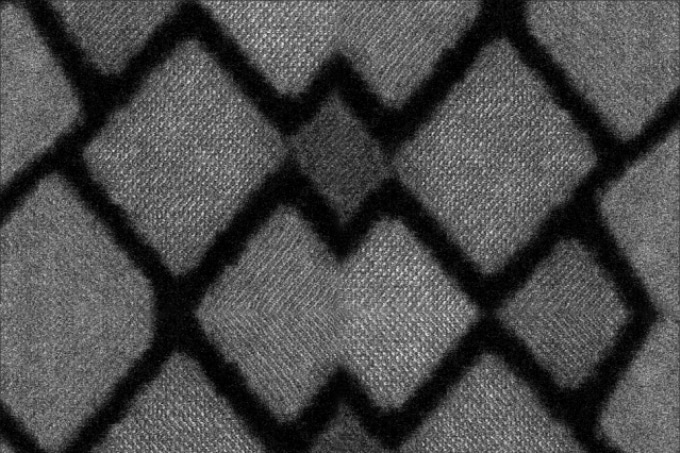Feb 22 2019
In the worldwide pursuit for creating practical computing and communications devices based on quantum principles, one prospectively useful component has been unachievable: a source of light containing individual particles that is ideally predictable, constant, and with steady characteristics.
 Scanning Transmission Electron Microscope image (STEM) of single perovskite quantum dots. New study shows that single perovskite quantum dots could be a fundamental building block for quantum-photonic technologies for computing or communications. (Image credit: Courtesy of the authors)
Scanning Transmission Electron Microscope image (STEM) of single perovskite quantum dots. New study shows that single perovskite quantum dots could be a fundamental building block for quantum-photonic technologies for computing or communications. (Image credit: Courtesy of the authors)
Currently, scientists from MIT and Switzerland have reported that they have taken major steps toward achieving such a single photon source.
The research involves using a class of materials called perovskites to develop light-emitting particles known as quantum dots and has been published in the Science journal on February 21st, 2019. The authors of the paper are MIT graduate student in chemistry Hendrik Utzat, professor of chemistry Moungi Bawendi, and nine others at MIT and at ETH in Zurich, Switzerland.
The potential to generate individual photons with accurately known and persistent characteristics, including a wavelength (or color) that never fluctuates, could be beneficial for various types of proposed quantum devices. Since each photon cannot be differentiated from the others with respect to its quantum-mechanical characteristics, it could be feasible, for instance, to delay one of them and then make the pair to interact with each other, in a phenomenon known as interference.
This quantum interference between different indistinguishable single photons is the basis of many optical quantum information technologies using single photons as information carriers. But it only works if the photons are coherent, meaning they preserve their quantum states for a sufficiently long time.
Hendrik Utzat, Graduate Student in Chemistry, MIT.
Several researchers have made attempts to generate sources with the ability to emit such coherent single photons, but all have had drawbacks. The properties of the photons are affected in unpredictable ways by the random fluctuations in the materials that surround these emitters, thereby destroying their coherence. According to Utzat, it is “fundamentally challenging” to find emitter materials with the ability to maintain coherence while also being stable and bright. He added that this is because not just the surroundings but also the materials themselves “essentially provide a fluctuating bath that randomly interacts with the electronically excited quantum state and washes out the coherence.”
“Without having a source of coherent single photons, you can’t use any of these quantum effects that are the foundation of optical quantum information manipulation,” stated Bawendi, who is the Lester Wolfe Professor of Chemistry. According to him, another significant quantum effect that can be tapped by using coherent photons is entanglement, where two photons typically behave as if they were one, sharing all their properties.
Colloidal quantum dot materials that were chemically made earlier had impractically short coherence times; however, this team found that when the quantum dots were made from perovskites, a class of materials set out by their crystal structure, they generated coherence levels that were over a thousand times better compared to the previous versions. Currently, the coherence characteristics of these colloidal perovskite quantum dots are now reaching the levels of standard emitters, for instance, atom-like defects in diamond or quantum dots developed by physicists using gas-phase beam epitaxy.
One of the greatest benefits of perovskites, according to the team, was that they emit photons in a highly rapid manner once they are stimulated by a laser beam. Such a high speed could be a vital property for potential quantum computing applications. They also have very little interaction with their surroundings, greatly improving their coherence properties and stability.
Bawendi stated that coherent photons could also be used for quantum-encrypted communications applications. A specific type of entanglement, known as the polarization entanglement, can be the basis for secure quantum communications that resist intrusion attempts.
Since the researchers have now unraveled these potential properties, the next step is to make efforts toward optimizing and enhancing their performance to make them scalable and practical. It is certain that they have to realize 100 % indistinguishability in the photons generated. To date, they have achieved 20%, “which is already very remarkable,” stated Utzat, already on par with the coherences achieved by other materials, such as atom-like fluorescent defects in diamond, which are already established systems and have been worked on for a considerably longer time.
Perovskite quantum dots still have a long way to go until they become applicable in real applications, but this is a new materials system available for quantum photonics that can now be optimized and potentially integrated with devices.
Hendrik Utzat, Graduate Student in Chemistry, MIT.
Since it is a new phenomenon, considerable work is needed to develop it to a practical level, stated the researchers.
Our study is very fundamental. However, it’s a big step toward developing a new material platform that is promising.
Moungi Bawendi, Professor of Chemistry, MIT.
The study was supported by the U.S. Department of Energy, the National Science Foundation, and the Swiss Federal Commission for Technology and Innovation.